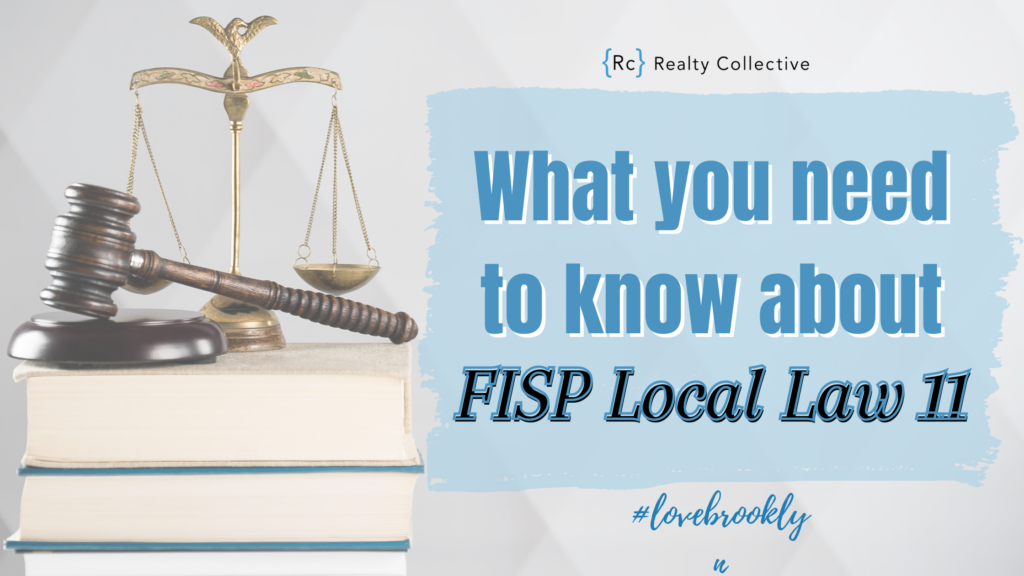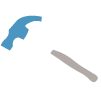What you need to know about FISP Local Law 11
Sep 29, 2023

FISP Local Law 11 NYC
The NYC Facade Inspection Safety Program (FISP), formerly known as Local
Law 11, requires NYC buildings taller than six stories to have their facades
inspected and repaired every five years.
In this article, we discuss the history of FISP and explain how Local Law 11
affects you as a buyer of New York City real estate.
Table of Contents:
What is the Facade Inspection Safety Program?
What is Local Law 11?
When do FISP / Local Law 11 inspections occur?
What is Local Law 10?
What is the difference between Local Law 11 and Local Law 10?
How does FISP / Local Law 11 affect me as a NYC home buyer?
What happens during a FISP / Local Law 11 inspection?
What is the Local Law 11 Cycle 8 schedule?
What are appurtenances?
What is the text of FISP / Local Law 11?
What is the Facade Inspection Safety Program?
FISP, formerly known as Local Law 11, requires that owners of buildings taller
than six stories have exterior walls and appurtenances inspected every five years.
Upon completion of the inspection, a building is required to file a technical
report with the department of buildings classifying façade elements as either
safe, safe with a repair and maintenance program, or unsafe. Unsafe façade
elements must be addressed immediately and repaired with 30 days.
FISP is designed to ensure pedestrian safety by prevent bricks, concrete and
other façade elements from falling on pedestrians. There are over 12,000
buildings in NYC which are subject to the inspection protocol of FISP.
The current FISP inspection cycle (Cycle 8) runs from February 21, 2015 through
February 21, 2019. The detailed FISP inspection, reporting and action
requirements are contained in RCNY (Rules of the City of New York) 103-04:
Periodic Inspection of Exterior Walls and Appurtenances of Buildings.
What is Local Law 11?
Local Law 11 of 1998, also known as the Façade Inspection Safety Program
(FISP), mandates the periodic inspection of the exterior walls and appurtenances
(such as balconies) of buildings greater than six stories in height in New York City.
Local Law 11 was an update to Local Law 10, which was the original measure
passed by the Mayor’s office to address pedestrian safety.
An inspection typically occurs once every five years, and it must be conducted by
a New York State Registered Architect (RA) or NYS Licensed Professional
Engineer (PE) with at least one year of relevant experience. The inspector is
called a QEWI, or a Qualified Exterior Wall Inspector. If any unsafe conditions are
discovered, the architect or engineer must immediately notify in writing the
building owner and the Department of Buildings.
Once the inspection is complete, the architect or engineer is required to file a
report of critical examination with the City’s Department of Buildings on the
condition of the building’s facade. In the report, the architect or engineer must
document the condition of the exterior walls and appurtenances as either safe,
unsafe or safe with a repair and maintenance program. Buildings are required to
report all unsafe conditions immediately and repair them within 30 days.
When do FISP / Local Law 11 inspections occur?
Local Law 11 inspection deadlines are divided into sub-cycles A,B, and C which
are determined by the last digit of a building’s block number. You can look-up a
building’s block here.
While buildings must be inspected every five years, building owners have two
years to file according to the sub-cycle they are in. The most recent inspection
cycle (Cycle 8) began on February 21, 2015 and runs through February 21, 2020.
Sub-cycles A, B and C are broken down as follows:
Sub-Cycle: Last Digit of Block Number: Filing Period/Deadline:
A 4,5,6 or 9 2/21/15 – 2/21/17
B 0,7 or 8 2/21/16 – 2/21/18
C 1,2 or 3 2/21/17 – 2/21/19
What is Local Law 10?
Local Law 10, passed by Mayor Ed Koch in 1980 as an amendment to the city’s
Building Code, was the first city ordinance designed to address and prevent the
safety risks posed by the deterioration of building facades in the city. The
ordinance was passed after Grace Gold, a Barnard College freshman, was killed
by a falling piece of terra cotta masonry on the Upper West Side (115th and
Broadway).
Local Law 10 was subsequently replaced and broadened by Local Law 11 in 1998
and FISP in recent years to further enhance safety and the overall effectiveness of
the façade repair program.
What is the difference between Local Law 11 and
Local Law 10?
Local Law 11 was passed by Mayor Giuliani in 1998 as an update and expansion
to Local Law 10. Local law 11 set much stricter requirements as to what needed
to be inspected and the rigorousness of the inspections themselves.
A number of public safety events led to the passage of Local Law 11. In 1997,
there was a partial building collapse on Madison Avenue. The collapse took
down part of the front of the building, which led the city to believe that it was not
sufficient just to inspect the street facing facades.
Whereas previously only the front façade and side walls up to 25 feet from the
street required an inspection, Local Law 11 mandated the inspection of all four
sides of a building. The only exception was for walls which are 12” or less from a
neighboring building. In addition, Local Law 11 also mandated a physical
inspection from scaffolding as opposed to visual ‘binocular’ inspection from afar
which were permissible under Local Law 10.
Local Law 11 also amended the report classifications from simply “pass” or “fail”
to “safe,” “unsafe,” or “safe with a repair and maintenance program.” This was
designed to ensure that buildings which required a repair and maintenance
program (and which may not be safe by the time of the next inspection) would
be addressed in a timely manner.
How does FISP / Local Law 11 affect me as a NYC
home buyer?
As a NYC home buyer, you should have your buyer’s agent inquire as to the
status of the building’s FISP compliance. FISP inspections can be very expensive
and time consuming. In addition, inspections may bring to light other repair work
which the building may need to complete.
NYC presents buildings with a unique combination of environmental threats
including winter freeze/thaw cycles, air pollution and salt which means that
facade decay of your building is a reality of owning an apartment in NYC. If the
condo, condop or co-op you are buying into does not have sufficient reserves to
pay for repairs, they may need to seek a loan, refinance or levy an assessment on
unit owners.
Determining the status of your building’s Local Law 11 compliance isn’t the only
reason to consider working with a buyer’s agent in NYC. By hiring a buyer’s
broker and requesting a NYC buyer agent commission rebate, you can actually
reduce your buyer closing costs and save thousands on your purchase.If your
purchase happens to be above $1 million, the rebate you receive will most likely
pay for the 1% NYC mansion tax.
A seasoned buyer’s agent in NYC can also increase your chances of a successful
deal by helping you assemble offer documentation, prepare a polished co-op
board package, coaching you for your board interview, allowing you to avoid the
risks of dual agency.
What happens during a FISP / Local Law 11
inspection?
Façade inspections, also known as critical examinations, may only be permitted
by a Qualified Exterior Wall Inspector (QEWI). QEWIs are either NY State
Registered Architects (RA) or NYS Licensed Professional Engineers (PE) who have
at least one year of relevant experience.
The inspection requires a physical examination to be undertaken from scaffolding
or some other form of observation platform.
Facades may be classified in one of three ways:
● Safe: No problems in good condition
● Safe With a Repair and Maintenance Program (SWARMP): Safe, but
requires repair/maintenance
● Unsafe: Problems/defects threaten public safety
If a facade is determined to be safe, no façade work is required during the cycle.
Facades designated as ‘SWARMP’ have the potential to become unsafe, however
no immediate action is required. In the technical report, the QEWI must offer a
specific month and year by when the condition must be rectified.
A facade may not be classified as “SWARMP” for two consecutive filing cycles. If
a facade was classified as SWARMP in the previous cycle and not yet repaired, it
must be reported in the next cycle as an unsafe condition.
Unsafe conditions must be reported to the DOB immediately and rectified within
30 days. In the meantime, the building must immediately install public safety
measures such as a construction fence or a sidewalk shed. If the repairs take
longer than 30 days, the commissioner has the authority to grant 90 day
extensions if certain conditions are met.
What is the Local Law 11 Cycle 8 schedule?
Local Law 11 (FISP) Cycle 8 began on February 21, 2015 and runs through
February 21, 2020. Cycle 8 is divided into three, two-year sub cycles. Your
building’s particular sub-cycle filing deadline depends on the last digit of your
block number on file with NYC.
The sub-cycles are broken down as follows:
Sub-Cycle: Last Digit of Block Number: Filing Period/Deadline:
A 4,5,6 or 9 2/21/15 – 2/21/17
B 0,7 or 8 2/21/16 – 2/21/18
C 1,2 or 3 2/21/17 – 2/21/19
What are appurtenances?
Appurtenances are defined as “exterior fixtures, flagpoles, signs, parapets,
copings, guard rails, window frames, balcony enclosures, window guards, window
air conditioners, flower boxes and any equipment attached to or protruding from
the facade” (RCNY §103-04). FISP Cycle 8 also mandates the inspection of
balcony railings in the wake of a 2013 fatality involving a woman who fell to her
death on the Upper East Side after her balcony railing gave way.
What is the text of FISP / Local Law 11?
1 RCNY §103-04
CHAPTER 100
Subchapter C Maintenance of Buildings
103-04 Periodic Inspection of Exterior Walls and Appurtenances of Buildings.
(a) Definitions.
Acceptable report. A technical examination report filed by a Qualified Exterior
Wall Inspector that meets the requirements of the Administrative Code and this
rule as determined by the Department.
Amended report. A technical examination report filed by a Qualified Exterior
Wall Inspector who certifies that the unsafe conditions reported in the initial
report have been repaired and that no unsafe conditions exist at the building.
Critical examination. An examination conducted to review the exterior of a
building and all parts thereof to determine whether the exterior walls (facades)
and the appurtenances thereto are either safe, unsafe, or safe with a repair and
maintenance program and whether, in the judgment of a Qualified Exterior Wall
Inspector, they require remedial work.
Filed report. A report shall be deemed filed with the Department when it has
been received by the Department. The filed report shall be completed in
accordance with the provisions of paragraph (3) of subdivision (b) of this section.
Filing window. The two-year period during which a report for a particular building
may be filed without penalty.
Qualified Exterior Wall Inspector (hereinafter “QEWI”). A qualified exterior wall
inspector as defined in section 101-07 of the rules of the department.
Report filing cycle. The five-year time interval established by the Commissioner
for the filing of each successive report for each successive critical examination of
every building subject to the requirements of Article 302 of Title 28 of the
Administrative Code.
Safe. A condition of a building wall, any appurtenances thereto or any part
thereof not requiring repair or maintenance to sustain the structural integrity of
the exterior of the building and that will not become unsafe during the next five
years.
Safe with a repair and maintenance program (hereinafter “SWARMP”). A
condition of a building wall, any appurtenances thereto or any part thereof that is
safe at the time of inspection, but requires repairs or maintenance during the
next five years in order to prevent its deterioration into an unsafe condition
during that five-year period.
Staggered inspection cycle. The separate time intervals for filing reports of
critical examinations as determined by the last digit of the building’s block
number, beginning February 21, 2010, and continuing thereafter for each
subsequent report filing cycle.
Subsequent report. A technical examination report that is filed by a QEWI after
an acceptable report in order to change the status of the building for that report
filing cycle to reflect changed conditions.
Unsafe condition. A condition of a building wall, any appurtenances thereto, or
any part thereof that is hazardous to persons or property and requires prompt
repair. In addition, any condition that was reported as SWARMP in a previous
report and that is not corrected at the time of the current inspection shall be
reported as an unsafe condition.
(b) Critical examinations.
1. Periodic inspection requirements. In order to maintain a building’s exterior
walls and appurtenances thereto in a safe condition, and in accordance with
Article 302 of Title 28 of the Administrative Code, a critical examination of all
parts of all exterior walls and any appurtenances thereto of all existing buildings
greater than six stories in height or buildings hereafter erected that are greater
than six stories in height, except for those parts of any exterior wall that are less
than twelve inches (305 millimeters) from the exterior wall of an adjacent
building, shall be conducted at periodic intervals.
2. Inspection procedures.
● Before any exterior wall for any building is critically examined, the QEWI
retained by or on behalf of the owner of the building shall carefully
review the most recent report and any available previous reports. The
Department will maintain a file of such reports submitted in
conformance with the law in effect prior to July 1, 2008 and with Article
302 of Title 28 of the New York City Administrative Code, and furnish
copies upon payment of fees set forth in the rules of the Department.
● Such examination shall be conducted and witnessed by or under the
direct supervision of a QEWI retained by the owner of the building or
his or her representative.
● The QEWI shall design an inspection program for the specific building
to be inspected which shall include, but not be limited to, the methods
to be employed in the examination. The inspection program shall be
based on the considerations of the type of construction of the building’s
envelope, age of the material components, the façade’s specific
exposure to environmental conditions and the presence of specific
details and appurtenances. Consideration shall be given to the façade’s
history of maintenance and repairs as described in previous reports and
submittals to the department. Except as provided in subparagraph (viii)
of paragraph (2) of this subdivision, the QEWI need not be physically
● present at the location when the examination is made. Architects,
engineers, tradesmen and technicians, working under the QEWI’s direct
supervision, may be delegated to perform selected inspection tasks
only when they are employees or subcontractors of the QEWI.
● The methods used to examine the building shall permit a complete
inspection of same. Except as herein required, the use of a scaffold or
other observation platform is preferred, but the QEWI may use other
methods of inspection as he/she deems appropriate. A physical
examination from a scaffold or other observation platform (a “close-up
inspection”) is required for a representative sample of the exterior wall.
The QEWI shall determine what constitutes a representative sample.
The representative sample shall include at least one physical
examination along a path from grade to top of an exterior wall on a
street front using at least one scaffold drop or other observation
platform configuration, including all setbacks.
● The known history of the building, the nature of the materials used and
the conditions observed will dictate the extent of the critical
examination. The QEWI shall utilize a professional standard of care to
assess the building’s condition, including splitting or fracturing of terra
cotta on buildings, cracking of masonry and brick work in brick faced
buildings, loosening of metal anchors and supports, water entry,
movement of lintel angles, and shall ascertain the cause of these and
such other conditions detected. The QEWI shall order any special or
additional inspections and/or tests that may be required to support
investigations and to determine the causes of any defects. The removal
of portions of the façade in order to facilitate the performance of tests
may require a permit from the Landmarks Preservation Commission.
● During the course of the critical examination, photographs shall be
taken and/or sketches made to properly document the location of all
conditions observed that are either unsafe or SWARMP.
● Upon discovery of any unsafe condition, the QEWI shall immediately
notify the Department and the owner of the building by letter or fax, in
a form and manner as provided by the Department.
● Completion of a critical examination shall mean that the QEWI has
conducted a final physical inspection to determine that the building
conditions as described in the report are consistent with the actual
conditions. Such final inspection shall, at a minimum, include an actual
visual examination and a walk around with binoculars or other
inspectorial equipment. A drive-by inspection is not acceptable.
3. Report Requirements
● The QEWI shall file with the Department and submit a copy to the
owner of the building a written report describing the result of the
critical examination, clearly documenting all conditions noted during
the inspection and stating that the inspection was performed and
completed in accordance with the Administrative Code and this rule. A
separate acceptable report must be prepared and filed for each
building, even if it shares a Block and Lot number with other structures.
● Technical information in the report shall adhere to and follow the
sequence and the labeling of the report requirements as listed in
subparagraph (iii) of this paragraph, and shall be provided on such
forms and in such format as the Department shall require. Additional
information may be provided. All letters (A – O) shall be listed in the
report. If a requirement is not applicable, this shall be indicated on the
report under the relevant letter.
● The report shall include an executive overview that shall consist of a
summary of findings and recommendations, a concise statement of the
scope of the inspection and findings, the conclusions and
recommendations and a determination as to whether the building is
categorized as “safe,” “SWARMP,” or “unsafe.” The report shall also
include, but shall not be limited to:
● A. The address, any a.k.a. addresses, Block and Lot number, the
Building Identification Number (“BIN”), the landmark status of the
building, the location from the nearest cross street, and a copy of the
Property Profile Overview from the Buildings Information System (“BIS”)
found on the Department’s website;
● B. The name, mailing address and telephone number of the owner of
the building, or, if the owner is not an individual, the name, mailing
address, telephone number, position/title of a principal of the owner;
● C. A description of the building, including the number of stories,
height, plan dimensions, Certificate of Occupancy number if available,
usage, and age and type of exterior wall construction;
● D. A detailed description of any settlements, repairs, or revisions to
exterior enclosures since the previous report;
● E. A detailed description of the procedures used in making the critical
examination;
● F. A detailed description of:
● 1. The extent and location of all physical examinations performed;
● 2. The names, addresses, telephone numbers, and license or
registration numbers for riggers and other consultants involved in the
critical examination;
● 3. A location diagram of a discernable scale and with a north arrow,
indicating the main entrance and nearest cross street and locations and
dates of close-up inspections; and
● 4. Dates of the start and completion of the critical examination;
● G. A description and classification of each significant condition
observed including deterioration and any movement detected and the
apparent water-tightness of the exterior surfaces. The description must
also include a list of all the exterior appurtenances and their condition.
Appurtenances include, but are not limited to, exterior fixtures,
flagpoles, signs, parapets, railings, copings, guard rails, window frames
(including hardware and lights), balcony enclosures, window guards,
window air conditioners, flower boxes and any equipment attached to
or protruding from the façade. Each condition must be classified as
safe, unsafe or SWARMP. If the building is classified as unsafe or
SWARMP, the report must include the locations and descriptions of all
unsafe or SWARMP conditions. Balcony railings must be inspected to
ensure that their components (balusters, intermediate railings and panel
fillers) are positively secured against upward movement (e.g. by welds,
bolts or screws). If any balcony enclosure is found not to be positively
secured, the condition is classified as unsafe and must be made safe
pursuant to the requirements of paragraph (5) of subdivision (b) of this
section. In the event a cycle seven report has already been filed with
the Department pursuant to paragraph (4) of this subdivision, a
separate report regarding the condition of the balcony enclosures must
be filed within cycle seven.
● H. An analysis of the causes of the conditions reported as unsafe or
SWARMP.
● I. A detailed status report of maintenance work performed up to the
date of submission of the report;
● J. A comparison of currently observed conditions with conditions
observed during the previous report filing cycle examinations, including
the status of the repairs or maintenance performed with respect to the
prior conditions. The following shall be included and discussed: 1. Work
permit numbers relating to façade repairs, including permits for sheds;
2. Job numbers, status and sign-off dates for any façade related jobs,
where applicable; and 3. Violation numbers of any open Environmental
Control Board (“ECB”) façade violations and the status of the repairs of
the conditions cited in the ECB violations;
● K. Detailed recommendations for repairs or maintenance of SWARMP
items, including:
● 1. The recommended time frame for such repairs or maintenance to be
performed, which shall indicate the date by which the work shall be
performed (MM/YYYY) to prevent the conditions from becoming unsafe
and not the date on which work is planned or scheduled;
● 2. Time frames of less than one (1) year, “ASAP,” or “immediately,” shall
not be accepted.
● L. A list and description of the work permits required to accomplish the
necessary work. If no work permits will be required, the reason shall be
indicated;
● M.
● 1. Color photographs of the primary house number and at least one
view of the entire street front elevation for all reports regardless of the
building’s filing condition, and color photographs and sketches
documenting any conditions that are either unsafe or SWARMP and
their locations. Photographs shall be at least 3” x 5” (76mm x 127mm)
in size, unless otherwise requested by the Department. The
photographs shall be dated and both the original photographs and all
required copies shall be in color.
● 2. The page/sheet size for attachments shall not exceed 11” x 17”
(280mm x 430mm).
● N. The classification of the building for the current report filing cycle, as
determined by the following guidelines:
● 1. If there are no unsafe conditions and no conditions that are SWARMP,
then the building shall be classified as safe;
● 2. If there is at least one unsafe condition, then the building shall be
classified as unsafe.
● 3. If there is at least one condition that is SWARMP and there are no
unsafe conditions, then the building shall be classified as SWARMP. A
report may not be filed describing the same condition at the same
location as SWARMP for two consecutive report filing cycles. The QEWI
shall certify that all of the conditions identified in the previous report as
requiring repair have been corrected or the building shall be classified
as unsafe;
● O. The seal and signature of the QEWI under whose direct supervision
the critical examination was performed.
(4) Report filing requirements.
The requirements of this rule shall apply to all buildings with exterior walls or
parts thereof that are greater than six stories in height, including the basement,
but not the cellar, as defined in the building code, and regardless of the
information in the Certificate of Occupancy. For buildings constructed on sloped
sites that contain six (6) full stories plus one partial story where more than half the
height of that partial story is above existing grade and/or adjacent to open areas
(e.g., areaways, yards, ramps), the wall containing that partial story shall be
subject to façade inspection. Conditions requiring façade inspections may also
include other structures that add to the height of the building as per section BC
504. The Commissioner shall determine which additional buildings and/or parts
thereof are required to file in accordance with this rule.
Buildings required to file a report shall do so once during each five-year report
filing cycle established by the Department. The next complete report filing cycle,
cycle seven, runs from February 21, 2010 to February 20, 2015.
An acceptable report shall be filed within the applicable two-year filing window
to avoid a late filing penalty, except for cycle seven, during which the applicable
filing window shall be:
A. Two years for buildings that meet the requirements of item (A) of
subparagraph (v) of this paragraph,
B. eighteen months for buildings that meet the requirements of item (B) of
subparagraph (v) of this paragraph and
C. twelve months for buildings that meet the requirements of item (C) of
subparagraph (v) of this paragraph.
The report shall be submitted to the Department along with a filing fee as
specified in the rules of the Department.
Beginning with cycle seven, which runs from February 21, 2010 to February 20,
2015, an acceptable report for each building to which this rule applies is due in
accordance with the following filing windows:
A. For buildings located within a block ending with the number four (4), five (5),
six (6), or nine (9), an acceptable report shall be filed within the filing window
starting February 21, 2010 and ending February 21, 2012.
B. For buildings located within a block ending with the number zero (0), seven
(7), or eight (8), an acceptable report shall be filed within the filing window
starting February 21, 2011 and ending August 21, 2012.
C. For buildings located within a block ending with the number one (1), two (2),
or three (3), an acceptable report shall be filed within the filing window starting
February 21, 2012 and ending February 21, 2013.
For every five-year report filing cycle thereafter an acceptable report is due in
accordance with the following filing windows:
A. For buildings located within a block ending with the number four (4), five (5),
six (6), or nine (9), an acceptable report shall be filed within the two-year filing
window starting February 21 of years ending in zero (0) and five (5) and ending
February 21 of years ending in two (2) and seven (7).
B. For buildings located within a block ending with the number zero (0), seven
(7), or eight (8), an acceptable report shall be filed within the two- year filing
window starting February 21 of years ending in one (1) and six (6) and ending
February 21 of years ending in three (3) and eight (8).
C. For buildings located within a block ending with the number one (1), two (2),
or three (3), an acceptable report shall be filed within the two-year filing window
starting February 21 of years ending in two (2) and seven (7) and ending February
21 of years ending in four (4) and nine (9). (vii)
Initial reports for new buildings greater than six stories in height shall be filed as
follows:
A. The report shall be filed five years from the date the first Temporary Certificate
of Occupancy or Certificate of Occupancy was issued, if that five year date falls
within the applicable filing window according to the last digit of the building’s
block number as provided in subparagraph (v) or (vi) of this paragraph; or
B. If five years from the date the first Temporary Certificate of Occupancy or
Certificate of Occupancy was issued falls outside the applicable filing window
according to the last digit of the building’s block number as provided in
subparagraph (v) or (vi) of this paragraph, then the initial report shall be filed
within the applicable two-year filing window for the next five-year cycle.
If contiguous zoning lots under single ownership or management contain
multiple buildings that are considered one complex where at least two buildings
of more than six stories in height fall into different filing windows as described
above in items (A), (B) and (C) of subparagraphs (v) and (vi) of this paragraph, the
owner or management shall choose one of the following report filing options:
A. An acceptable report for each building to which this rule applies may be filed
separately according to the filing window corresponding to the last digit of that
individual building’s block number; or
B. The owner or his or her representative may choose one of the applicable filing
windows and file a report for all of the buildings within that filing window,
regardless of that building’s individual filing window. The owner or his or her
representative shall inform the Department 180 days prior to the end of the
assigned filing window if this option is chosen. If an owner or representative
chooses this option, the owner or representative shall continue to file under this
same filing window for the duration of the owner’s ownership of the property.
A report shall be filed within sixty (60) days of the date on which the QEWI
completed the critical examination (final inspection date), as defined in
subparagraph (viii) of paragraph (2) of subdivision (b) of this section. Failure to file
a report within sixty (60) days of the completed critical examination requires a
new critical examination.
A report may not be filed more than one (1) year after completion of the close-up
inspection.
If the report is not acceptable and is rejected by the Department, a revised
report must be filed within forty-five (45) days of the date of the Department’s
rejection. If the report is not acceptable after two (2) rejections, a new initial filing
fee as specified in the rules of the department is required. Failure to submit a
revised report addressing the Department’s objections within one (1) year of the
initial filing requires a new critical examination, including a new close-up
inspection.
A subsequent report indicating revised conditions may be filed within a five-year
report filing cycle to change a building’s filing status for that cycle.
The Department retains the right to destroy any copy of reports not picked up by
the owner within thirty (30) days after the date of its acceptance or rejection by
the Department.
5. Unsafe Conditions
Upon filing a report of an unsafe condition with the Department, the owner of
the building, his or her agent, or the person in charge of the building shall
immediately commence such repairs or reinforcements and any other
appropriate measures such as erecting sidewalk sheds, fences, and safety netting
as may be required to secure the safety of the public and to make the building’s
walls and appurtenances thereto conform to the provisions of the Administrative
Code.
All unsafe conditions shall be corrected within thirty (30) days from the
submission of the critical examination report.
Within two weeks after repairs to correct the unsafe condition have been
completed, the QEWI shall inspect the premises. The QEWI shall obtain permit
sign-offs as appropriate and shall promptly file with the Department a detailed
amended report stating the revised report status of the building, along with a
filing fee as specified in the rules of the Department. If the report is not
acceptable and is rejected by the Department, a revised report must be filed
within forty-five (45) days of the date of the Department’s rejection. If the report
is not acceptable after two (2) rejections, a new amended filing fee as specified in
the rules of the department is required. Sheds or other protective measures shall
remain in place until an amended report is accepted; however, the QEWI may
request permission for the removal of the shed upon submission of a signed and
sealed statement certifying that an inspection was conducted, the conditions
were corrected and the shed is no longer required. Permission to remove the
shed may be granted in the Commissioner’s sole discretion.
The Commissioner may grant an extension of time of up to ninety (90) days to
complete the repairs required to remove an unsafe condition upon receipt and
review of an initial extension application submitted by the QEWI, together with:
A. A copy of the original report for that report filing cycle and all required
documentation submitted with such report;
B. Notice that the premises have been secured for public safety by means of a
shed, fence, or other appropriate measures as may be required;
C. A copy of the contract indicating scope of work to remedy unsafe conditions;
D. The QEWI’s estimate of length of time required for repairs;
E. A statement of all applicable permit requirements;
F. A notarized affidavit by the owner of the building that work will be completed
within the time of the QEWI’s stated estimate; and
G. a fee as specified in the rules of the Department.
Note: Financial considerations shall not be accepted as a reason for granting an
extension.
A further extension will be considered only upon receipt and review of a further
extension application, together with notice of:
A. An unforeseen delay (e.g., weather, labor strike) affecting the substantially
completed work; or
B. Unforeseen circumstances (e.g., fire, building collapse); or
C. The nature of the hazard that requires more than ninety (90) days to remedy
(e.g., new wall to be built).
Note: Financial considerationows shall not be accepted as a reason for granting
an extension.
6. Conditions that are safe with a repair and maintenance program.
The owner of the building is responsible for ensuring that the conditions
described in the critical examination report as SWARMP are repaired and all
actions recommended by the QEWI are completed within the time frame
recommended by the QEWI, and are not left to deteriorate into unsafe
conditions before the next critical examination. It is the owner’s responsibility to
notify the Department of any deviation from the timeframe to make corrections
as specified in QEWI’s report. Such notification shall be accompanied by
supporting documents from the QEWI justifying the request for a new time
frame. The department may approve or disapprove such request.
A report may not be filed describing the same condition and pertaining to the
same location on the building as SWARMP for two consecutive report filing
cycles.
The QEWI shall certify the correction of each condition reported as requiring
repair in the previous report filing cycle, or report conditions that were reported
as SWARMP in the previous report filing cycle as unsafe if not corrected at the
time of the current inspection.
(c) Civil Penalties.
● Failure to file. An owner who fails to file the required acceptable
inspection report shall be liable for a civil penalty of one thousand
dollars ($1,000) per year immediately after the end of the applicable
filing window.
● Late filing. In addition to the penalty for failure to file, an owner who
submits a late filing shall be liable for a civil penalty of two hundred fifty
dollars ($250.00) per month, commencing on the day following the
filing deadline of the assigned filing window period and ending on the
filing date of an acceptable initial report.
● In addition to the penalties provided in this section, an owner who fails
to correct an unsafe condition shall be liable for a civil penalty of one
thousand dollars ($1,000) per month, pro-rated daily, until the unsafe
condition is corrected, unless the commissioner grants an extension of
time to complete repairs pursuant to this section. This penalty shall be
imposed until receipt of an acceptable amended report by the
department indicating the unsafe conditions were corrected or an
extension of time is granted.
● Challenge of civil penalty.
● An owner may challenge the imposition of any civil penalty authorized
to be imposed pursuant to this subdivision by providing proof of
compliance. Examples of such proof shall include, but are not limited
to, a copy of an acceptable initial report, a copy of the acceptable
amended report, copies of approved extension of time requests while
work was/is in progress or written proof from a QEWI that the unsafe
conditions observed at the building were corrected and the violation
was dismissed.
● Challenges shall be made in writing within thirty (30) days from the date
of service of the violation by the department and send to the office/unit
of the department that issued the violation. The decision to dismiss of
uphold the penalty shall be at the sole discretion of the department.
(d) Penalty waivers; eligibility and evidentiary requirements.
Owners may request a waiver of penalties assessed for violation of Article 302 of
Title 28 of the Administrative Code, the 1968 New York City Building Code
and/or rules enforced by the Department. Requests shall be made in writing and
shall meet eligibility and evidentiary requirements as follows:
(1) Owner status.
i. New owner requesting a waiver due to change in ownership shall submit proof
of a recorded deed evidencing transfer of ownership to the current owner after
penalties were incurred, as well as any other documentation requested by the
Department, and only in one of the following circumstances:
A. the new owner has obtained full tax exemption status from the New York City
Department of Finance; or
B. the new owner took title of the property as part of an economic development
program sponsored by a government agency.
ii. A new owner of a government-owned property requesting a waiver due to
change in ownership shall submit official documentation from the government
entity affirming that the premises was entirely owned by the government entity
during the period for which a waiver is requested.
iii. An owner may be granted a waiver of penalties upon submission of a copy of
a bankruptcy petition, together with proof that either the department or the New
York City Law Department was served with a “Notice of Bar Date.”
(2) Building status. An owner requesting a waiver because the building was
demolished shall submit city or departmental records evidencing the demolition
of the building prior to the filing deadline.












